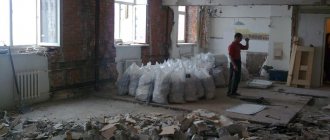Houses built in the 30s - late 50s of the last century, colloquially called Stalin buildings, have always been of interest to resale buyers due to their undoubted advantages: high ceilings, large windows, good space. However, repairs in Stalin buildings require large investments, and the reason for this is worn-out utility lines, the need to replace wiring and serious work with leveling floors and walls.
The investment in a major renovation will be fully repaid by enjoying a comfortable new kitchen.
Where to start repairs
Despite the fact that a Stalinist kitchen is usually small in size and sometimes may not exceed 5 square meters in area, if you are going to renovate it, you need to be prepared for large expenses. And it’s not just the need to replace windows, doors, pipes and electrical wiring.
Thick walls in old houses make it possible to make additional cabinets and even a refrigerator.
You will have to re-lay the floors, level the walls and ceiling, and, if possible, even remodel the room, since the whole family, perfectly accommodated in the luxurious Stalinist meters, simply will not fit into the small kitchen.
Before starting renovations, it is necessary to make a design for a new kitchen that reflects its future interior. Mark the places where the sink, dishwasher, furniture set will be located - the communications and electrical wiring connections will depend on this.
To make the kitchen comfortable, you need to think in advance about the location of furniture, appliances and sockets.
Features of Stalin's buildings
Despite their venerable age, Stalinist houses are still popular among the population. The rooms in the apartments are large, spacious, with high three-meter ceilings, wide corridors, large kitchen area and pantry. Thick walls, reaching a meter thickness, retain heat well and have good sound insulation.
A positive quality of steel buildings is that all the floors in them are made of reinforced concrete, the main walls are replaced by beams - crossbars installed under the ceiling. Thanks to this, most of the walls do not bear the main load, which makes any redevelopment inside the apartments possible. It doesn't look exactly aesthetically pleasing, but with the help of decoration it looks beautiful.
We will not redo the already good redevelopment of the apartment. It will take a different path.
Replacing communications
Replacing communications is a necessary stage in starting a kitchen renovation. The replacement of communications should be considered taking into account the places where the main water consumers will be located according to the original design.
If you plan to install a dishwasher, change the location of the sink and move a gas stove, you should consider the following rules:
- water and sewer pipes and hoses must not exceed one and a half meters in length and must remain accessible for inspection;
- Flexible gas hoses can only be stretched up to four meters in length.
A good solution for the kitchen is to hide the pipes behind cabinets without back walls: they will not spoil the look of the kitchen and will remain accessible.
Pipes in Stalin steel, especially if major repairs have not been carried out, must be replaced. In old pipes, not only do fistulas and cracks form, but from the inside they become almost 70% clogged with salts and sediments, which reduces their throughput.
Taking this opportunity, you can make global changes and move the sink to a more convenient place
It is quite possible that when replacing a sewer pipe from the kitchen, the question of replacing the entire sewer pipe will arise. Even if a major overhaul was once carried out, you should inspect the location of the pipes - for some reason, it was in Stalin buildings that the housing office liked to run new pipes in the middle of the wall.
New water pipes prevent blockages.
The new water supply and sewerage system is made of metal-plastic or polypropylene pipes, which are characterized by ease of installation, durability, and good performance characteristics.
After replacing the water supply and sewer lines, you need to call gas workers to assess the condition of the gas pipes. After their conclusion, gas pipes are replaced under the supervision of specialists. However, often there is no particular need for this, except for moving the place for the gas stove.
New communication pipes are the basic rule for home safety.
Disadvantages of Stalinist apartments
Undoubtedly, such ancient housing also has its disadvantages:
- Low power electrical wiring
- Outdated and in need of repair communications
- Problems with off-street parking
- The presence of small balconies or their complete absence
- Mostly kitchens have a small footprint
- Various problems requiring repair
Since the buildings were built a long time ago and the communication pipes have become unusable, very often a radical and simple solution to such a problem is impossible.
Replacing electrical wiring
The electrical wiring in the kitchen in the Stalinist style, as in the entire apartment, will definitely have to be changed. The fact is that from those years, aluminum wiring was preserved in Stalin, designed at most for a chandelier and a refrigerator.
Now the electricity consumption in a Stalin apartment should be calculated based on the presence of the same refrigerator, dishwasher, microwave, electric kettle, hood, powerful lighting and other household appliances. The cable must be changed to copper with a cross-section of no less than 8 kW. You will also have to install a voltage relay, replace the packets, and install a voltage stabilizer.
It is advisable to decide in advance what equipment will be in the kitchen and eliminate all weak points in the wiring.
It is more difficult to replace if the walls are shingles: you will have to lay the electrical cable on a flammable base, and install socket boxes and distribution boxes in wood. The electrical wiring will have to be built into a corrugated insulating pipe. If the walls are cinder concrete, foam concrete or gypsum, the work will be easier. In this case, ordinary grooves are made in the walls.
The kitchen should have enough outlets for all appliances and appliances.
Typical layout of Khrushchev apartments
“Khrushchevka” refers to five-story buildings, the construction of which began in the period 1956-1964, during the reign of Khrushchev. In Moscow, these buildings were built until 1972, and in the region itself and in many other regions of the country - until the mid-1980s.
At first, Khrushchev houses were built of brick, but in the 60s, for economic reasons, panel housing construction began. Apartments in “Khrushchev” buildings have a small area of rooms (for example, 6-9 m2 were allocated for a bedroom), and the area of kitchens does not exceed 6 m2. The ceiling height has also decreased - to 2.5 meters.
The main disadvantages of the layout of Khrushchev apartments include:
- Poor thermal insulation (hot in summer and cold in winter);
- Combined bathroom;
- Lack of garbage chute, elevator, attic.
But these houses also have their advantages. This is, first of all, the low cost of apartments and a good territorial location - close to the metro, in areas with developed infrastructure.
Layouts of apartments of standard series - Khrushchev:
Rice. 4 — Layouts of one-room apartments in Khrushchev Fig. 5 — Layouts of two-room apartments in Khrushchev Fig. 6 — Layouts of three-room apartments in Khrushchevka
Wall repair
Stalinist walls may simply be uneven, or they may even develop deep cracks. In any case, they will have to be strengthened and leveled. Some people completely remove the layer of old plaster, which can reach up to 10 cm in thickness, fill the shingles with a mesh and plaster the top with any gypsum plaster, or sew up the gypsum board. You need to understand that reducing the thickness of the ceiling between apartments leads to noise insulation problems.
Drywall makes the walls perfectly smooth and improves sound insulation.
Wall leveling today is usually done using drywall. This design allows you to hide an additional layer of sound insulation between the wall and the gypsum board. You can stick tiles on drywall, fix plastic panels or stick wallpaper. However, if you have the skill, you can level the walls using plaster mixtures, which are sold in sufficient quantities today.
If you want to combine the kitchen with the next room or expand the room through the corridor, you can remove the partition, especially if it is made of wood with shingles. Before dismantling the wall, you need to carefully examine the ceiling: rotten ceiling boards can only be supported by a partition.
Only partitions can be moved; capital walls cannot be touched.
Dismantling is carried out from above - first the partition is freed from the layer of plaster, and then the boards begin to be sawed off. This work cannot be called easy - since even pine boards over decades of use could become as strong as stone.
Moving the partition of a small kitchen allows you to place additional furniture.
Definition and features: what kind of houses are these - “Stalin”
During the reign of I.V. Stalin, many apartment buildings of two floors and above were built in the USSR. All of them were built from brick or cinder blocks and equipped with public amenities: running water, sewerage, water heating. It is these buildings that people talk about when they explain what type of house it is - “Stalinka”. Barracks, houses without utilities and one-story buildings are not included in the list.
Most of the houses of that time were built in the style of neoclassicism or the Stalinist Empire style, which is characterized by monumentality, pomp and Soviet symbolism.
It is customary to distinguish several classes of Stalinist housing:
- Pre-war. It was built without haste and with great attention to detail. Many houses have become not only comfortable housing, but also a decoration of the city.
- Nomenclature. It was intended for the upper classes, therefore it provided large rooms for various purposes: an office, a nursery, a library. There was even housing for servants. There were usually no more than four apartments per floor.
- Director's. It was intended for big bosses, so it was more modest. Buildings above five floors had elevators, and often individual garbage chutes. Most often, such buildings were built according to individual projects.
- Typical (ordinary). They were mainly built for communal settlement with appropriate features. Often such houses were no higher than two floors.
Depending on the class, the pros and cons of “Stalin” houses vary somewhat. However, general characteristics can be identified.
Floor and ceiling
If the ceiling in Stalin usually does not cause problems - it can be plastered, leveled, monolithic ceiling tiles glued to it, a suspended ceiling can be hung, then with the floor the list of work will be longer.
All errors in the old ceiling are easily hidden under the hanging structure.
The old floor is dismantled, since many of the boards are usually already rotted by this point. Mountains of garbage are usually found under the boards, and if there were problems with the sewer pipes before the repair, then they are also saturated with a fetid odor. This garbage must be collected and thrown away, and the gaps between the joists must be covered with expanded clay to create a heat and sound insulation layer.
Replacing the floor makes it possible to make it warmer and improve sound insulation.
Everyone makes the floor pie at their own discretion.
There are more than a dozen pie options:
- Expanded clay up to 20 cm, mesh for reinforcement, screed up to 4 cm, laminate or parquet.
- 2 layers of plywood on logs 15mm thick in level while maintaining horizontality, backing, linoleum or laminate.
If the floor is reinforced concrete, you can level it with a light wet screed or buy a regular dry screed, for example, from Knauf.
Laminate flooring is great for modern kitchen renovations.
I live in a “Stalin” building on Dvoryanskaya: a stove in the kitchen and a retro photo under the floor
Famous and not very well-known, old and not quite - there are so many interesting houses, apartments and their inhabitants in Vladimir that we wanted to talk about them in a separate section called “I live here.” For example, Daria Arkatova and her husband bought an apartment in a building with an 85-year history and now talk about the details of the transformation of the living space on their Instagram blog “Stalinka” on Dvoryanskaya.”
“According to the documents, the house was built in 1938 and was originally intended for the management staff and employees of the VZPO Tekhnika. Stalin’s “mansions” occupy four floors, on the attic, fifth, there is a hostel, which can be entered from the first and fourth entrances.”
Last December, the couple received the keys and started “with two knives”: they tore off the wallpaper on their own. Today the apartment is being renovated by a construction team, the floors are being restored and the walls are being prepared. The ideas are grandiose: one of the craftsmen will restore the former stucco molding under the ceiling.
“The walls are uneven, they go a few centimeters in one direction or the other. This is probably due to the imperfection of the technologies of those times, and in such “edits” - the complexity of renovating an old apartment. However, before they were still built very well, not like now.”
In the Soviet era, the room was divided by a partition for renting to two families. Subsequently, the layout was complicated by the former hostel here. The current owners are planning to restore the fence and get a living room and a bedroom with a balcony.
@stalinka_na_dvoryanskoy“We heard “accusations” about the dilapidation of communications in such houses, but our pipes were assessed and said that they would last for a long time. But there are a lot of problems with the floor. The boards lay on the joists, the space between which was completely filled with dirt: recycled coal, glass, sand. This “mass” served as sound insulation, but currently only emits toxic dust. We removed almost 260 bags.”
Old boards will be restored: turned over, laid back, sanded and varnished. According to the owners, during this time the wood has dried to optimal condition and is now much better than the new material.
“There is a stove in the kitchen area, which is rumored to be working. But we will not “play with fire”: we will install a decorative brass cap on the chimney and cover the surface with vertical tiles, as they do in St. Petersburg. We'll also change the windows, because it's really windy. We’ll supply good ones: with lamination, wood-look, soundproofing.”
The balcony is the highlight of the apartment. The family wants to live in safety, and therefore follows news about home improvements. The process of restoration of the facade has been going on for a long time and is still on the agenda of the responsible services.
Daria started blogging just to see the “before” and “after”, which sparked the interest of the public, who “planted” several stories about the apartment in the “Stalin” building.
“According to urban legends, the Reitzman family lived here, whose home was later bought by black realtors. They promised to find out the exact information in the archive. The findings of our “excavations” also preserve the same history: in the floor we found pencils from the Sacco and Vanzetti factory, cigarette packs, and newspaper clippings. The “collection” is crowned by the student report card of the Maltsevsky vocational school, now “aircraft mechanics,” and photographs depicting the same girl.”
According to the owner, a rare second-hand item is beautiful. Secondly, the location played a role in the choice: the city center, and therefore the accessibility of infrastructure and communications. The owners plan to complete the renovation by summer and enjoy the dream come true.
Make a redevelopment
In some cases, it is impossible to do without remodeling a Stalinist kitchen. There are interesting houses that were actually built in the pre-Stalin period, but which are also called Stalinist buildings.
When designing microdistricts of such houses, it was envisaged that residents would eat in dining rooms in the courtyard, and the kitchen was intended only for drinking tea at night. Of course, with an apartment size of 60-80 square meters, a kitchen of 4 square meters will not be able to perform its functions.
Sometimes the kitchen table is only suitable for a cup of morning coffee.
Such kitchens can be combined with an adjacent room, making a dining room there, and leaving the functional area in the same place. There is an option to simply move the partition one and a half meters into the next room and cover it with plasterboard.
This, by the way, is a more legal option, since according to the standards, gasified kitchens must be separated by a door from living quarters. To solve this problem, you can use popular sliding structures, including glass ones.
Often redevelopment is the only way to make a small kitchen comfortable
Layout of a one-room Stalinist apartment No. 3 with a kitchen-dining room
Advantages:
- The kitchen-dining room is located separately from the main room, so no extraneous odors or noise will disturb you and your guests.
- The apartment has a bathroom and a separate toilet, which is very convenient. The spacious hallway can accommodate a spacious closet, a separate shoe rack and a bench for your convenience.
- In the main room there is a large folding sofa, a TV area, a desk and a wardrobe.
Flaws:
- For a family with a small child, space should be provided for a crib and children's furniture. You may have to replace the sofa with a bed to fit everything you need.
Note:
- On the balcony you can install a dressing table and an additional shelf or cabinet.
Choosing the right style
A Stalinist kitchen is an opportunity to realize all your design dreams. If the Stalin style is nomenklatura and the stucco molding has been preserved under the ceiling, you can play with this element by building a classic or Soviet interior in the kitchen. Classic interiors love spacious rooms, so you shouldn’t implement them if the kitchen area is less than 8 square meters.
In a smaller kitchen, a modern style - minimalism or loft - will look great. High ceilings, very large windows - all this contributes to good natural light.
In a Stalin kitchen you can realize the most daring design ideas
Preservation of Stalinist values in the interior
When renovating Stalinist apartments, special attention must be paid to the floor. Over time, the boards become unusable and require replacement. When they are removed, the slag that has turned into dust over time must be removed. Rotten logs are replaced, the space between them is filled with expanded clay, then gypsum fiber boards are laid. After this, they begin to repair the walls.
If it is not possible to restore the stucco molding on the high ceilings of the apartment, it can be replaced with gypsum baseboards, cast overhead convex strips and stucco rosettes around the lamps. Colored walls with multi-colored stained glass windows can add brightness to the apartment.
Choice of colors
The peculiarity of Stalina is the high level of illumination in the kitchen. Even a very small kitchen will look spacious, and if you decorate the walls, ceiling and furniture in light colors, it will be easy to breathe and a joy to work in. Even in a small kitchen, but well lit thanks to a large window, rich furniture fronts and contrasting bright accents will look great.
The harmonious combination of a light background and rich accents enlivens even the smallest kitchen space.
Compact furniture
The small kitchen area dictates the choice of a compact but very functional interior. It is even possible to arrange tall cabinets, similar to Soviet pencil cases, up to two or two and a half meters.
The built-in wardrobes are very spacious and allow you to place all kitchen utensils.
You can also increase storage space by using a furniture plinth with drawers. If you replace the wide and deep Stalin-era window sill with a marble or granite one, you can use it as a work area.
The space under the cabinets can be used functionally with drawers.
For a small kitchen, a linear layout of the furniture set is chosen, for a more spacious one - L-shaped or U-shaped, but provided that a passage between the furniture elements is at least 1 meter wide. Unfortunately, it is not always possible to place kitchen corner sofas in a small kitchen. A table and chairs are a great option.
Transformable furniture solves the problem of lack of space in a small kitchen.
Mid-century, Stalin-era design
In the 30-60s, furniture was mainly made from natural wood. Upholstered furniture, tables, and chairs had simple shapes supported by legs. Many interior elements were made by hand. Retro furniture from the Stalin era with knitted curtains and a tablecloth can change the appearance of the apartment. You can complement the interior with old string bags and suitcases.
You can emphasize the era of Stalin times with the help of retro furniture and accessories corresponding to that time. The highlight of such an interior will be the good old parquet, which cannot be replaced by any modern floor covering. The interior of the era of those times is associated with scale and calm, which are felt immediately after entering the room.
How to hide a gas water heater
A gas water heater with an open combustion chamber is usually hidden in a false cabinet without a bottom or top, but with a 15-cm indentation from the side walls in accordance with gas service standards. However, in a kitchen decorated in a modern high-tech or loft style, the column and pipes can not be hidden, but can even be used as a decorative element.
If the requirements are met, you can hide the geyser in a closet along with the pipes.
What it is?
Stalinist or Stalinist houses are considered to be residential buildings erected during the reign of Joseph Vissarionovich Dzhugashvili (Stalin). Architecture flourished between the 1930s and 1950s.
Buildings in the so-called “Stalin Empire style” are especially popular: they are distinguished by bright, memorable decorative elements and a monumental appearance.
The most notable of them are the “seven sisters” - Stalinist high-rise buildings erected in the center of Moscow in 1947-1957. The list includes the main building of Moscow State University, the Ukraine and Leningradskaya hotels, the Ministry of Foreign Affairs, as well as residential buildings: all of them are multi-story, and are also crowned with a remarkable spire.
How Stalin buildings differ from buildings of other times will be discussed in the next section.
Built-in technology
You will have to buy kitchen appliances in a Stalinist kitchen of the minimum size and build them in whenever possible. It is better to place the dishwasher in the space under the sink, choose a tall and narrow refrigerator, and a narrower stove. A gas hob will be a good solution in a small kitchen when solving functional problems.
Furniture of reduced dimensions can be built into the set and save the necessary space.
A hob instead of a full-fledged stove frees up space for additional drawers.
Design of a one-room Stalinist apartment: 4 layouts
The layout of a one-room apartment, most often, is a rather difficult task, because in a small area you need to place all the necessary furniture, things that accumulate over the course of your life, and so on.
In addition, it can be difficult to provide in the space of one main room an area for a child, your rest and work, and a wardrobe. Today, using the example of four options for planning solutions, we will talk about the most effective ways of competent and thoughtful use of living space.
Lighting
Thanks to the high ceilings, any type of lighting can be used in the Stalin apartment, including chandeliers in combination with spotlights around the perimeter. Unfortunately, precisely because of the same three-meter ceiling height, lighting with one chandelier may not be enough. Therefore, it is necessary to provide for the presence of additional light above the work area, above the apron, on the railing, as well as an additional sconce near the dining table.
Abundance of light creates a cozy atmosphere in the kitchen.
A Stalinist kitchen can be renovated and converted into a more comfortable space. A huge plus is the high ceilings and large windows. You most likely won’t be able to carry out the repairs on your own - there is too much work: replacing wiring, replacing pipes.
Corridor
The high ceilings of Stalinist apartments make it possible to create two-level ceilings not only in the rooms, but also in the corridor. The corridor looks beautiful in black and white with a combined ceiling made of plasterboard sheets and matte PVC film. For lighting, along with a chandelier, you can use built-in spotlights and LED strip. Wallpaper is selected in light colors. The floor is laid out with graphite-colored gypsum tiles, the edges are framed with light tiles. Black gypsum tiles are used to cover door openings and floor frames instead of baseboards.











